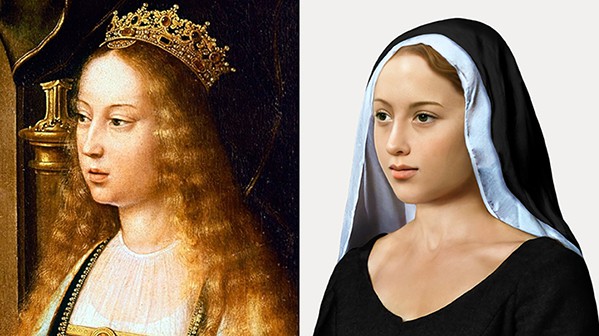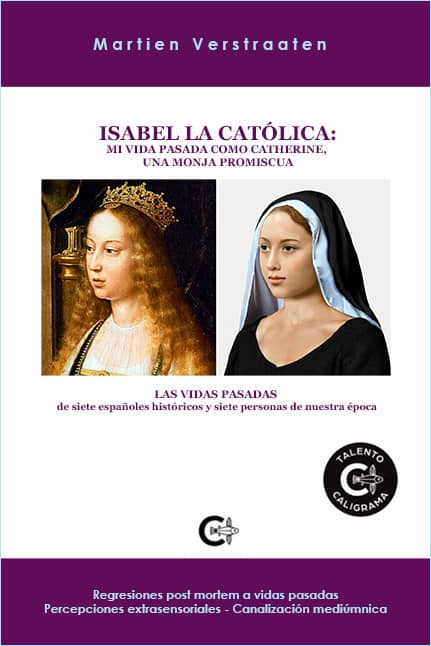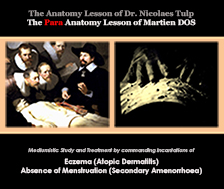In search of the portrait of Catherine of Auvergne…
It’s late in the evening and I am getting ready to turn in for the night. Just for a second, I glance at a piece of paper where earlier that day I had jotted down the name Becca Saladin (currently known as Becca Segovia). A friendly board member of a museum had tipped me to approach Dallas graphic designer Becca Segovia for a historical portrait reconstruction of one of the main characters of my new book about past lives, Spanish Queen Isabel la Católica. The plan was to have a historical reconstruction, a recreation, made of her appearance, her face and attire of her incarnation, a past life, as Catherine of Auvergne, a promiscuous beautiful 14th-century French nun.
Before being in Morpheus’ arms, I opened Royalty Now on Instagram and was thunderstruck to see the multifold of recreations of historical figures. This was what I had been looking for. I had meticulously described the life of the lesbian nun Catherine of Auvergne, who was one of the protagonists in my new book about past lives and had seen her face many times at my extrasensory screen. However, I had to request, and if possible, instruct Becca Segovia to work historically in reverse. Not a trip from the past to a present existence with which she was quite familiar with, but a journey from a foregone era, the 15th century, to a more distant past, the 14th century, a complete retrograde movement.
In addition, the almost longing and passionate energy with which she poured into the portraits in large numbers appealed to me. What an enormous hunger this designer must have had, an insatiable appetite for shape and colour, obviously originating from one or more significant past lives. That’s how I saw art historically, how I knew parapsychologically, as well as how I also felt energetically as a passionate salsa dancer. My eyes, my mind´s eye or third eye and related antennae were trained to recognize quality. This allowed me to suitably judge thousands of drawings, and paintings worldwide as a professor of art at several universities and as member of the board of the Dutch Groninger Museum, an internationally renowned museum of modern art.
Segovia Travel
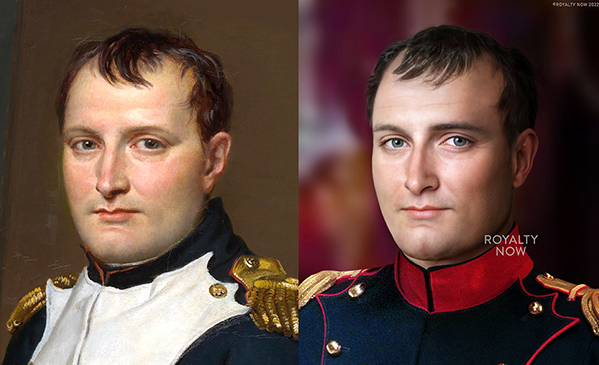
Graphic designer Becca Segovia travels historically, witness her diptychs, beautiful double portraits, from the past to the present. We can see what Napoleon Bonaparte, Henry VIII or Simon Bolivar would look like in our time. From Dallas, Texas, where she currently resides, to Hawaii, and from Brussels to St. Petersburg, hosts of followers can check out her latest creations on her Instagram account, Royalty Now (@royalty_now_).
Her art-historical approach, linking the past to the present, seems fictional, symbolic, even hypothetical. Her question: What might Julius Caesar look like in the present is not as fictitious as it seems from a historical-reincarnative point of view.
Edgar Cayce (Hopkinsville, KY 1877 – Virginia Beach, VA 1945), the Sleeping Prophet, one of the most accomplished mediums of all time, reported in one of the 14,306 readings that an entity for whom a reading was requested, a 12-year-old boy living in Bellefontaine, Ohio, in a previous incarnation went through life as Roman Senator Marcus Brutus, infamously known as one of the conspirators in the deadly attack on Julius Caesar. Brutus later went on to make a fortune as governor of Cyprus by borrowing money at high rates, and later committed suicide.
The readings revealed that for unknown reasons many children were born in Bellefontaine, appeared to have had incarnations during the time of the Roman Empire. He was referring not only to people (entities) who were of high socially standing at the time, such as Brutus, Caesar or Nero, but also to people in ancient Rome who had rubbed shoulders with these Roman royals. During reading no. 5366-1, held on 19th of July 1944, related to the health of a Mrs. referred to as (F 53), also from or near Bellefontaine, who had been in her past life an associate of the Roman emperor Nero, Cayce exclaimed: “My! Some very interesting characters born near Bellefontaine!”
So, it is not unreasonable to imagen royals from bygone eras today with contemporary faces attired in jeans, perhaps sporting a lip piercing while taking in Miami Beach. So, in a reincarnative and parapsychological sense, the portraits of Segovia are indirectly based on the truth.
Segovia’s continued success subsequently led to the Gods seemingly having new challenges in store for her: a historical reverse journey, an artistic experiment, to travel from the past to an even more distant past. The messenger sent by the spirits or Gods for this experiment was yours truly Martien Verstraaten, mediumistic journalist, ghost-writer for deceased historical persons and therapist for historical regressions to past lives.
A reverse trip for Becca Segovia? From present to past would mean, what would current royals and VIPs like Barack Obama, (the late) Diana, Princess of Wales, Sir Elton John, Stephen Hawking, or Oprah Winfrey have looked like in the past, for example in a past life? – and for Segovia the experiment could represent a new artistic development. By portraying the Spanish Queen Isabel la Católica as the elegant and promiscuous nun Catherine of Auvergne, a previous incarnation, fate took a first historical step in this direction.
Her artistic historical journeys from past to present unmistakably testify to (unconscious) great mediumistic gifts, I must say professionally. Neptune, the planet for psychics, imagination like dreaming endlessly of other times, even unconsciously dwell daily in past lives, makes a dynamic (paranormal) aspect with the Moon in one of the Venus signs, Libra (the arts, and like Taurus, predilection for beautifully ‘painted’ mouths). As the holder of an almost identical aspect in my chart, I know that a Neptune-Moon aspect can direct emotionally the images from the past into the present.
Her Neptune, conjunct Uranus, trines beautifully with Jupiter, like all her contemporaries do. However, her Moon, the personal factor in a horoscope, is perfectly connected to these three collective planets, so that she has professionally a deep connection with the spirit of the time. The Moon in a horoscope represents the people, it will indicate if, and the degree of popularity the owner will attain. Therefore it´s not surprisingly her work is renowned across the board with both peers and non-contemporaries, in tune with the spirit of the time.
The sign Sagittarius (affinity with foreign royalties) is emphasized because it contains Sun (conjunct) Mars and Mercury. The fiery planet Mars in the fiery sign Sagittarius makes a powerful connection with Saturn in Aquarius (the spirit of the time). Mars sextile Saturn gives fiery stability through passionate technology (how to control photoshop technically). What more could you want, especially for an almost clairvoyant designer? A necessary powerful planet Pluto, I would recommend. And let’s say, Pluto’s position in the horoscope of Segovia is powerful and special, in the sign of Scorpio.
The position of Pluto in the martial sign of Scorpio is by nature strong, towards the dominant and magical, and in her chart, Pluto is an unaspected planet. So, the planet of the will can act in all directions, for good and for bad, it can suggest prominence, power, and influence. Portraits emerging from her mesmerizing Neptune-Moon nirvana can be brought to the public’s attention by Pluto with almost extra-terrestrial power. As a result, by the time entire colonies of humans live on the Moon and Mars, her portraits will also have been on display there, for sure. Segovia’s personal attitudes, referred astrologically by Neptune and Pluto, are the result of an artistic, almost art-historical, and powerful past life in a Russian oblast in the Urals that preceded the present life and that underlies unmistakable the entity of the current diptychs.
Looking at her collected works, you might also wonder which deceased early medieval or Renaissance portraitists guided her daily when she “painted” the double portraits while composing on her “canvas”, the computer. However, the fact is she is assisted by members of the painters’ guild of olden days. A gifted painter or designer, working with egg tempera, acrylic paint or through endless photoshopping, but also a musician or writer while working, is always helped by spirits, inner or outer and often without being aware of it: small inner voices, suddenly emerging ideas, impulses, a smell, a sound, and so on.
Art criticism and the hybrid structure of the arts
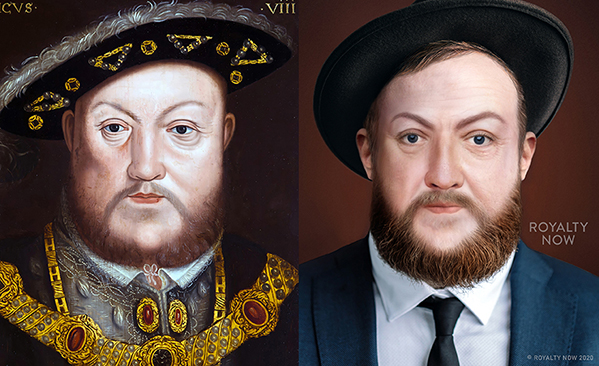
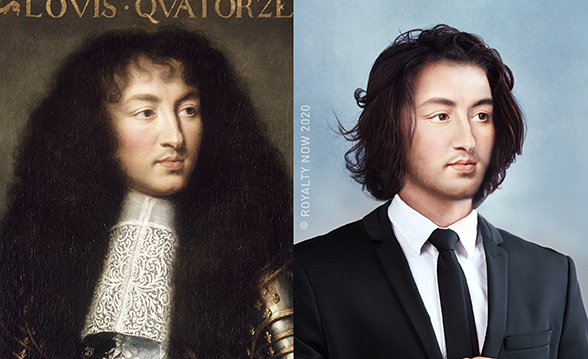
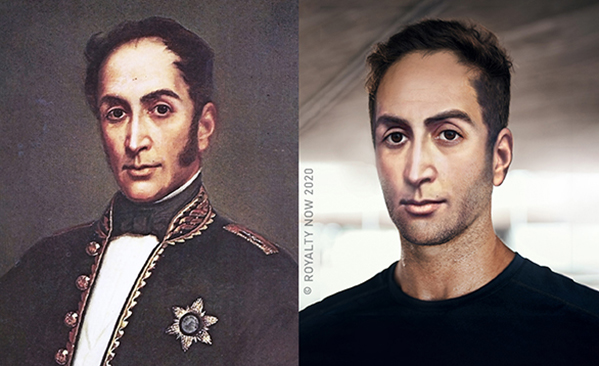
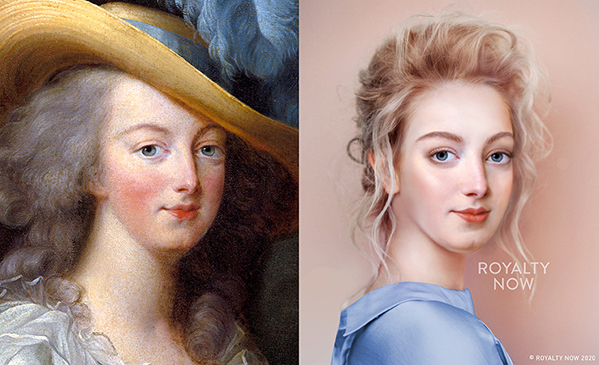
In the early 1980’s Frans Haks, former revolutionary director of the Groninger Museum, was the first worldwide to bring in a group of American graffiti artists, the discussion was again about what should be understood by art. Much earlier, from Marcel Duchamp and the Dadaists, we knew what we needed to know: The structure of art is assimilative and kaleidoscopic by nature. Until then, illustrations and other works by the graphic drawing pen often belonged to a different domain of the (applied) arts.
Successive presentations of Documenta Kassel, the Venice Biennales and Art Basel Miami Beach or Hong Kong show that the arts have developed in a broad spectrum of applications, often hybrid and interdisciplinary: philosophical, historical, geopolitical, climate-conscious, or social critical.
When considering the double portraits of Becca Segovia, the question arises how her work could be classified historically. She started working on her first portrait out of boredom, as she stated in an article in El País in 2020. That hobby out of boredom, has grown into a true passion for art and history, making the past tangible for visitors of Royalty Now Studios, her beautiful gallery online. From an art-historical point of view, her message is an indirect one, the personal pleasure of making beautiful pictures, the aesthetic art for art’s sake. However, in the depths, it seems there is also a second motif, a motivational fascination: to match what portrait painters were able to achieve throughout the ages without the use of photoshop or polaroid cameras. The future will undoubtedly show how Becca Segovia has further developed artistically.
The current immense adoration for portrait painting from other times radiates from her portraits, both through the choice of the portrait painters of her preference, to the use of color when she sometimes gives details just a little extra contrast, so that cheeks get a little more blush. Segovia makes you imagine a former blind man who, after successful eye surgery, eagerly awaiting to finally seeing the divine world, or as Vincent van Gogh, after leaving the leaden sky of northern Europe, can finally inhale the Mediterranean light of Arles and as a fauvist avant la lettre wrote history.
Looking at Segovia’s portraits raises the question of whether and where she has seen all the paintings of the old masters of portraiture she loves so much.
What comic or picture book of art history, virtual or on paper, did little Becca have available as a child, and which pages were looked at the most? Pages culminating in the Flemish primitives, the Italian, or the Northern Renaissance? Or would she have visited in person, as a child or young lady through all the museums, from the Hermitage in Saint Petersburg and the Prado in Madrid to the Louvre in Paris, and the Uffizi Gallery in Florence? An impossible task one would think.
If not, could the cause of her passion be found in internally stored experiences of the soul that originated in one or more past lives? Could Segovia have visited many museums in an incarnation other than the American one and carried all those memories with her to her current life?
One thing is certain, the explosion of Segovia’s realized forms and colors has a significant origin, a clearly traceable history. As if artistic obstacles from a distant past, it seems to me as a medium, wanted to be cleared in the service of a more satisfying future use. Powerful motives therefore led her to incarnate again, this time in Woodstock, Illinois, the United States, the country that gave birth to one of the greatest “illustrators”, the genius Pop Art celebrity Roy Liechtenstein. Where would her incarnative anchors be? Time to track down her imaginary comic or picture book of the royalty arts.
“Hurry up, hurry up”. A past life in Yekaterinburg: trips to Paris, Vienna, Florence, and other Italian cities
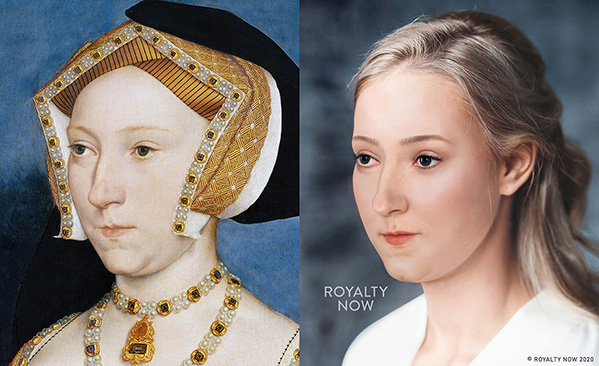
Gradually looking at Segovia’s work, but now as a medium, the images perceived in a trance state takes me unmistakably to a related significant past life. An alleged immaterial comic or picture book in which her inner images are located, and which have led to her current work comes closer.
When the first images of trance enter my mind, it is as if I opened a book by the Russian master of storytelling Анто́н Па́влович Че́хов, known as Anton Chekhov, (1860-1904), and I immediately step into a past life of Becca Segovia, the graphic designer of Royalty Now.
However, we are not in Dallas, Texas, blessed with a pleasant climate, but in the Russian Urals, in Yekaterinburg, a socially important city, which is much colder, especially in winter. We see a lively, enterprising, and a very impatient, slim young adult. Olga, who, after her mother has died, is father’s comforter (“hurry up, hurry up”, she invariably calls to the servants).
Olga, with bright blue-grey eyes, is slightly taller than the average young lady her age. From her mother she is endowed with medium blond long hair that, viewed from the front, falls in two parts over her shoulders. An elegant dress, which she had made of thin French fabric, is gathered from chest height. The position of her left shoulder, almost invisible, a single millimeter lower than the right one. This is due to the sternum, also not detectable, being slightly twisted since birth, a family feature on the mother’s side, with which she bears a great resemblance, and this genetic condition causes her to tire after embroidering for too long.
Her father Carol, who wears a large saber-shaped Russian moustache, is a high-ranking police officer who also serves as an investigating judge and envoy extraordinaire, dressed in an impressive black ceremonial uniform with stripes and gold buttons. Olga’s family has belonged to the high Russian nobility for generations, and their relationship with the Romanov dynasty, with successive tsars, is remarkably close.
The homely atmosphere is cultural, educational, considering Russian etiquette, Russian and French are spoken alternately. The decor of the salon, which is located on the first floor of the large country house and offers a view of bare trees in winter, is dominated by several large French Gobelins with impressively realistic depictions that cover almost the entire wall.
With a close eye on one of the depictions on the Gobelin, Olga, embroidering with one of the well-known embroidery stitches, is copying a realistic depiction of the Gobelin. In the absence of sufficient technical abilities to be able to paint, Olga will often meticulously copy several types of representations, including portraits, while embroidering.
As the only child in a family of high nobility, she is spoiled. Trips abroad with her father are frequent. Dad surrenders to her passion for visiting museums in France and Italy in addition to museums in Russia. He arranges for her to reside with a Parisian family in order to get a better grasp of French. She visits the Louvre frequently and is soon as at home in Paris as she is in Yekaterinburg.
On one of her trips abroad with her father, to Paris and Vienna, she saw a painting by Hans Holbein the Younger in Vienna, that later in her life became part of the Kunsthistorisches Museum, depicting Jane Seymour, wife of Henry VIII, on which a meticulously painted embroidery, her hobby, can be seen on the sleeves. She stands before the panel in adoration and despair. On the one hand in adoration of both Jane Seymour and the painter, Hans Holbein the Younger, and on the other hand in complete despair for not having the skills or being able to paint like this famous master, this Hans Holbein the Younger. A feeling that will settle deep in her soul for centuries, and from which she wants to be healed one day.
When she dies in the early 20th century, she imaginatively takes all the paintings she once admired with her in her soul, in an inner museum full of stately portraits of royals by early or late medieval masters. Portraits she would like to paint herself in a future incarnation, with or without photoshop.
Project ‘Isabel becomes Catherine’: Extrasensory transmission, Texas-Andalusia vice versa, finetune the picture
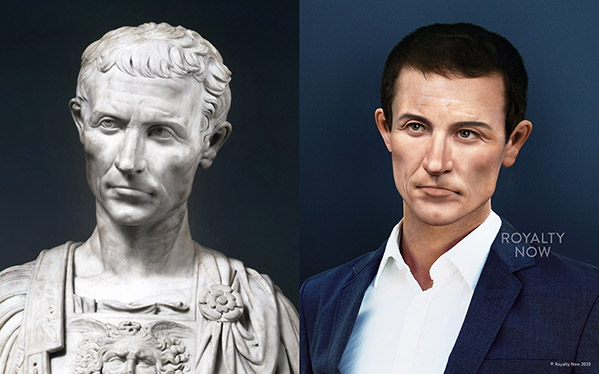
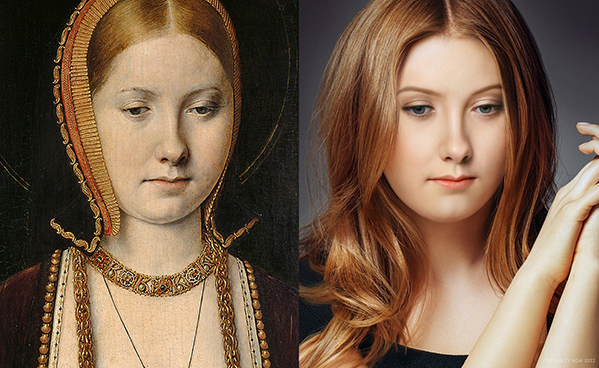
Contact with Becca Saladin, as I knew her by name in 2021, was quickly established. As a visual artist and professor at several universities of applied sciences, but also as a former board member of one of the most prominent museums in the Netherlands, the Groninger Museum, I was demanding and critical. However, I was not familiar with the practice of portraiture at the level of Hans Holbein the Younger, Giotto, or Albrecht Dürer.
Given the full order book of Becca Segovia, we had to wait several months before our project could start. One of the first actions I took during that time was to send written detailed excerpts from the life of the lesbian nun and later abbess, Catherine of Auvergne.
Life is a learning process. I was assigned the task of conveying observations and thoughts about Catherine’s psyche and appearance in such a way that Segovia clearly picture the nun´s face in her mind.
Catherine was a stunningly beautiful nun, blessed and cursed with a powerful libido, but nevertheless distinguished by disposition, originating in part from the higher nobility of Burgundy. Despite the persistence of the internet and other means of communication, it was not easy to tune into specific thoughts of a client thousands of miles away.
The result of Becca Segovia´s first test of competence for anatomical sculpting, the creating of Catherine´s face and bust, fell into my box. I was stunned, even moved, this was Catherine, as I had observed her many times paranormally as a medium! The skin of the Venusian face, and of the open chest area, as if Peter Paul Rubens had painted it with much love, almost brought tears to my eyes. It could hardly be otherwise that the deceased spirit of Isabel la Católica had imperceptibly directed designer Segovia during the creation of her (Isabel´s) incarnation as Catherine. This part of the assignment was completely successful.
The second stage of the project has started. Clothing, and especially the headgear, I wanted historically to correspond to the religious dress in Burgundy and Auvergne of the 14th century and to be related to that of the Cistercians order, as I had previously observed the clothing in trance. Then, metaphorically speaking, Catherine was sent to a medieval shop in Auvergne to acquire the historically accurate headgear. My psychic observations served as signage, after which Becca Segovia ‘digitally purchased’ the elegant headgear.
The project was special in many ways.
Feminine love, lesbianism is of all times, and no less in medieval monasteries. Historically, sexuality has been a taboo subject in Abrahamic religions from time immemorial. From the ancient Christian era to their present era, if we are to believe old-fashioned historians, sexuality was solely for (sacred) reproduction, not for personal pleasure: saints versus sinners.
On the contrary, documents recently brought to light in the Vatican archives conclude that the monasteries of medieval nuns were indiscrete venues of lesbian-sexual relations. The boredom, bitterness and lust of the novices and nuns were the basis of poetic and sexual trysts. Therefore, under the direct eye of God, lesbian love games and sexual acrobatics were the rule rather than the exception (Benware, 2017, Bietris de Romans, n.d.).
The magnificent final product has been realized by Becca Segovia, as can be seen in this article, which can compete in perception and quality with the gallery of portraits shown from Napoleon Bonaparte to Marie Antoinette. My colleagues, international professors of art, politicians, and mediums, share the same opinion.
Any lesbian nun´s mouth will water to be allowed to say an act of contrition with the blindingly beautiful Catherine of Auvergne.
The cover of my new book on the past lives of Spanish historical figures and contemporary living ones, entitled Isabel la Católica: Mi vida pasada como Catherine, una monja promiscua, will feature the portrait of the beautiful Catherine.
Thanks to Becca Segovia, her guiding spirits, as well as mine.
July 9th, 2022,
ADDITION TO THE PAST LIFE OF BECCA SEGOVIA
As a result of Becca Segovia’s past life in Russia, she requested to know some specific details. Again, I went into a trance to answer, if possible, some of her fundamental questions. The result, also for me as medium, was spectacular and to a significant extent insightful.
Motives to incarnate, as is known, can be quite different in nature and intensity. General or world-view motives, socio-cultural participation, and contributions to a new era in history, as well as motives of a very personal nature, the re-meeting of a person emotionally or intellectually important to the entity, a soul contact, can surface.
The degree and form of emotional affinity with a country in which one lived in a past life is determined by the kind of experiences the entity had. A past life full of joy provides, of course, other “memories and associations” in the present than, for example, a complicated incarnation without inner sunshine. One can have great affinity with Japanese Zen, Butoh (dance)theatre and with the typical high Japanese manners, formal politeness, but not with Japanese food or their climate.
Strong preferences and distinctive character traits as sub-personalities always point to different past lives. The willpower can come from incarnation A, the creativity from incarnation B, and all relational problems from incarnation C. Of course, several character traits can come from one and the same past life.
The affinity of Becca Segovia for royals stems undeniably from the Russian incarnation. In addition, I must add that in a series of her past lives, long ago, the entity often had an incarnation in and around royal circles.
The Balkan Peninsula
The motive to incarnate as Olga in Russia has its origin in the Balkans. In the incarnation that preceded the Russian one, the entity lived in the Balkans. The entity was a sweet, beautiful young girl, a child, about eight years old, of short stature, who was partially blind and deaf, this was due to an illness in the past or an infection. In addition, she was poor, despite this she remained inwardly of royal blood, dignified, a legacy from other past lives. Often in the morning, she sat like a princess on a throne, a large stone, from a small hill “watching” the Mediterranean Sea that could be “seen” in the distance, breathing the fresh sea air. She couldn’t see the sea, but she could smell it, so she could still see the sea by smelling. Her traditional clothing was torn, but colorful and made of thick fabrics.
In the observed image, the colored fabrics refer to cultures from the Middle East and, curiously, also Peru.
A horse rider from France
One morning sitting on her rock, a horseman passes. The man, as I perceive, is 30 or 35 years old. She feels the steps vibrations of the hooves on the ground and when passing she sees in a blur a black figure sitting on the horse. The man in a black cape passes her again the next morning and after driving past a few times he gets off and stands in front of her. In her language he asks her why she sits on the stone alone every day. The man turns out to be from a foreign country, France, which she has never heard of. He is temporarily a guest in the area where she lives. Sympathy and friendship gradually develop between the two. As a child he represents to her inwardly the opposite of all kinds of poverty, material and immaterial, he comes from the big world, she loves him. In addition, he is very sweet, the way he talks, the interest he has in her, in her illness, her bad eyes and ears, the human love that he carries within and expresses. After several weeks he says that unfortunately he must return to his country, and he has to say goodbye.
Remaining alone on the stone, she wants and must see him again, that nice man, who was like a father to her. But she doesn’t know how to see him again. And where is that country, France?
To incarnate
The sweet little girl on her throne of stone has never forgotten the Frenchman who touched her heart, her spiritual father on horseback, and she takes that thought with her when she dies. When the time comes to incarnate again and the entity starts looking for new parents that match in a reincarnative way, the entity of the former Balkan girl spots the Frenchman while looking down at the earth. He is in France, visiting Paris, while he lives in Russia. The spiritual daughter-father love flares up within the soul. He must become the entity´s father and will become his or her father. Finally, based on all kinds of cosmic laws, Carol becomes the father of the dearly beloved girl from the Balkans who endeared him and who will listen to the name Olga.
By choosing to incarnate with Carol and his wife, the entity kills two birds with one stone. She becomes the daughter of the man she loved so much in the past, is drawn into a life of international royalty, and can often connect for her legendary France.
The age of both
Olga’s Russian life has recently been largely described by me. Olga remained unmarried, did not need a husband. She chose independence and freedom, emancipation avant la lettre, men could only have hindered her in her development. Olga, left-handed, was always busy, until old age, we would call it now attention deficit hyperactivity disorder (ADHD) which also kept her slim, in relation to Intellectual giftedness.
Father Carol reached an advanced age. She cared for him lovingly until his death, no effort was too much for her, her act was not obligatory but out of love and deep friendship. Olga was also very old by the standards of the time, as strange as it may sound, around ninety or even slightly beyond. She died of old age, no special illness, although she had smoked heavily in recent years. One night in 1915 she breathed one last breath and that was all. She fortunately no longer lived through the October Revolution of 1917, in which many befriended royals would be murdered.
PS. Various incarnations took place within an educational cycle of past lives, a learning process, alternating poor versus rich, both material and immaterial. This included life in the Balkans and Russia.
July 11th, 2022. Comment Becca Segovia
Thank you so much for the extra information, Martien! This was a fascinating read. I really appreciate you taking the time to do that.
Recommended Literature
Bennett, Judith. History Matters: Patriarchy and the Challenge of Feminism. Philadelphia: University of Pennsylvania Press, 2006.
Bennett, Judith. “Lesbian-Like” and the Social History of Lesbianisms. Journal of the History of Sexuality, 2000, 9, no. 1/2 (2000): 1-24. Retrieved November 9, 2017, from http://bit.ly/2AqlhcK
Benware, Maggie. Lesbians in the Middle Ages: Bietris de Romans. Young Historians Conference, 2017, 10. Retrieved November 4, 2017, from http://bit.ly/2iHmS6I
Bietris de Romans. “Na Maria, pretz e fina valors.” En Troubadour Poems from the South of France, translated by William D. Paden, y Frances Freeman Paden, n.d., 239.
Cayrol Bernardo, Laura, y Mercedes Pérez Vidal. Between the Cloister and the World: Women Religious in Europe and the Americas (11th – 17th century). Amsterdam: University Press.
Curb, Rosemary, y Nancy Manahan. Monjas Lesbianas: se rompe el silencio. Barcelona: Seix Barral, 1985.
Fernández Santos, Jesús. Extramuros. Barcelona: Argos Vergara, 1978.
Quirós, Paloma. “Como era Isabel y Fernando en la cama.” Reseña RTVE, 2013. Retrieved November 9, 2017, from http://bit.ly/2zfD9Hz.
© MARTIEN VERSTRAATEN
Psychic & mediumistic healer. Past life regression therapist.
Into practice since 1985 (The Netherlands, Curaçao, Brazil, Spain).
Mediumistic journalist. Author.
Occupied post
Professor of Visual Arts and Experimental Methods
Faculty of Education of the Nijmegen polytechnic “Gelderse Leergangen”
currently
HAN University of Applied Sciences, Arnhem and Nijmegen, The Netherlands
Professor of Visual Arts and Metaphysical Methodology of Learning
Faculty of Education of the Leeuwarden polytechnic “Ubbo Emmius”
currently
NHL University of Applied Sciences, Groningen and Leeuwarden, The Netherlands
Formerly governor of art and culture
Member of the board for Cultural Advice of the County of Groningen
Groningen, The Netherlands
Member of the general board of the Groninger Museum
Groningen, The Netherlands
_______________________________________________
DESTINATIONS – Laboratory for Intuitive Intelligence
Spain – The Netherlands – Curaçao – Brazil
CONSULTORIO PARANORMAL ANDALUCÍA
Jerez de la Frontera, Cádiz, Spain
www.martienverstraaten.com

